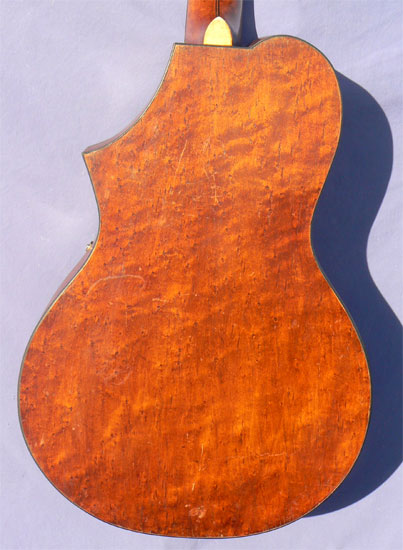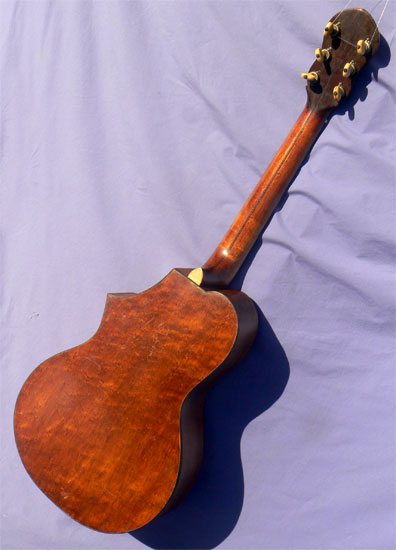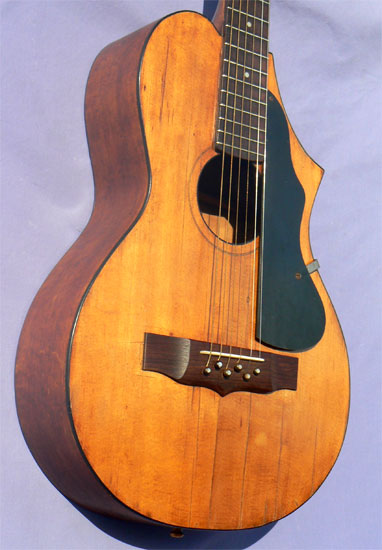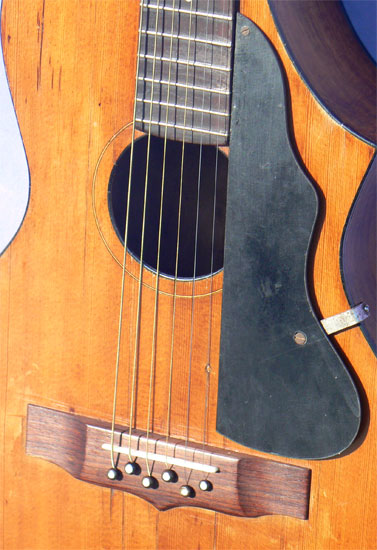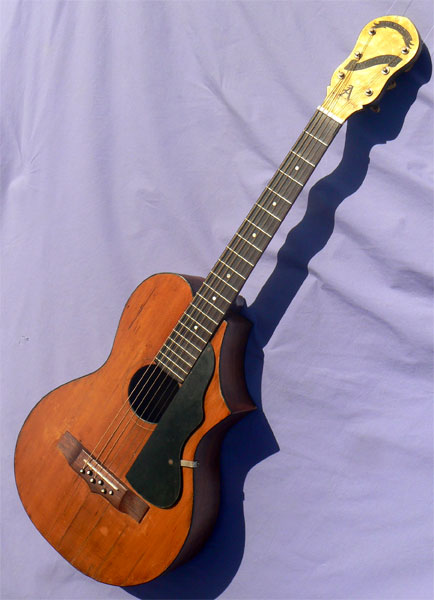
Home / Instruments /Accessories / Ordering / Tips / Friends
archtop.com
c.1930 Epiphone Recording Model 'A'
Status: Pricing and hold status for all instruments currently available is shown on our Instruments page here. If this instrument does not appear on the Instruments page it has been sold, and is no longer available. Photos and descriptions of Previously Sold instruments may be found here. To be notified of examples of this model or similar instruments in the future, please contact [email protected],. Please be specific on which instrument(s) you're looking for, and we'll be happy to contact you as soon as they become available. .
Serial #: 113 stamped in neck block. Body width: 13 1/2" Scale length: 25 1/2" Nut width: 1 3/4" Neck depth, 1st/8th frets: .90/1.13
Materials and Hardware: Solid Adirondack spruce soundboard; birdseye maple laminate body; multi-ply maple neck with rosewood fingerboard; rosewood bridge with bone nut; pearl dot fingerboard inlays. Nickel Grover planetary banjo tuners; vintage correct Bakelite pickguard.
Notes: Moving from Asia Minor to New York at the turn of the 20th century, the Stathopoulo family began production of professional quality banjos in the mid-1920's. Their top-line 'Recording' model banjos were designated from 'A' to 'E', in ascending order of ornamentation. As dance orchestras began to prefer the warmer timbre of the acoustic guitar, by 1930 the Epiphone company had debuted a new line of guitars as well, all named after their corresponding banjo models.
Offered in both 13" 'Concert' and 15" 'Auditorium' body sizes, Epi's Recording model guitars featured a radical design. With an extended hump on the bass side of the neck, and a steeply cut body on its treble side, the guitars subtly echoed Gibson's Florentine Style O Artist Models of earlier decades. Predating Selmer's Maccaferri models by several years, Epiphone's Recording series may well be regarded as the first true cutaway guitars from a major manufacturer.
But if innovation was the model's strong suit, timing was its enemy. Introduced just as the stock market was cratering, the Recording models were quickly supplanted by Epiphone's new archtop guitar line. And so, with a production window of scarcely over a year, Epi's A through E models promptly became some of the rarest acoustic guitars of the 20th century.
This early Style 'A' model features a Concert size body, with a solid, slightly arched Adirondack spruce top, and a smartly figured birdseye maple back and sides. Initially fitted with a tailpiece and floating bridge, these early Recording model guitars were soon redesigned with pin bridges, and this guitar was similarly refitted with a rosewood bridge, bone saddle, and one replacement inlaid bridge pin as well.
The paddle shaped peghead pays tribute to it's banjo lineage, with its showy engraved pearloid banners and Grover planet banjo tuners. It's banjo DNA is further reflected on the fingerboard as well, with a position marker at the 10th fret, instead of the usual 9th fret dot common to American guitars.
At just 4lb 4oz, the guitar is notably light in weight, and well balanced in the lap. The dark rosewood fingerboard is straight and true, over the reinforced multi-ply maple neck, with smooth low action and a fresh, high precision setup. Several grainline cracks in the soundboard have been soundly resealed, with a newer coat of matte lacquer finish applied to the top, and a vintage correct polished Bakelite pickguard suspended over the body. The voice is bright and snappy, with a blend of archtop projection and flat top sustain and reverb. The generous 1 3/4" nut is ideal for both pick and finger style play, and the guitar is a versatile companion for a variety of traditional music styles.
A daring, pioneering design, and a fleeting rarity in the history of the 20th century guitar. One only: call now.
